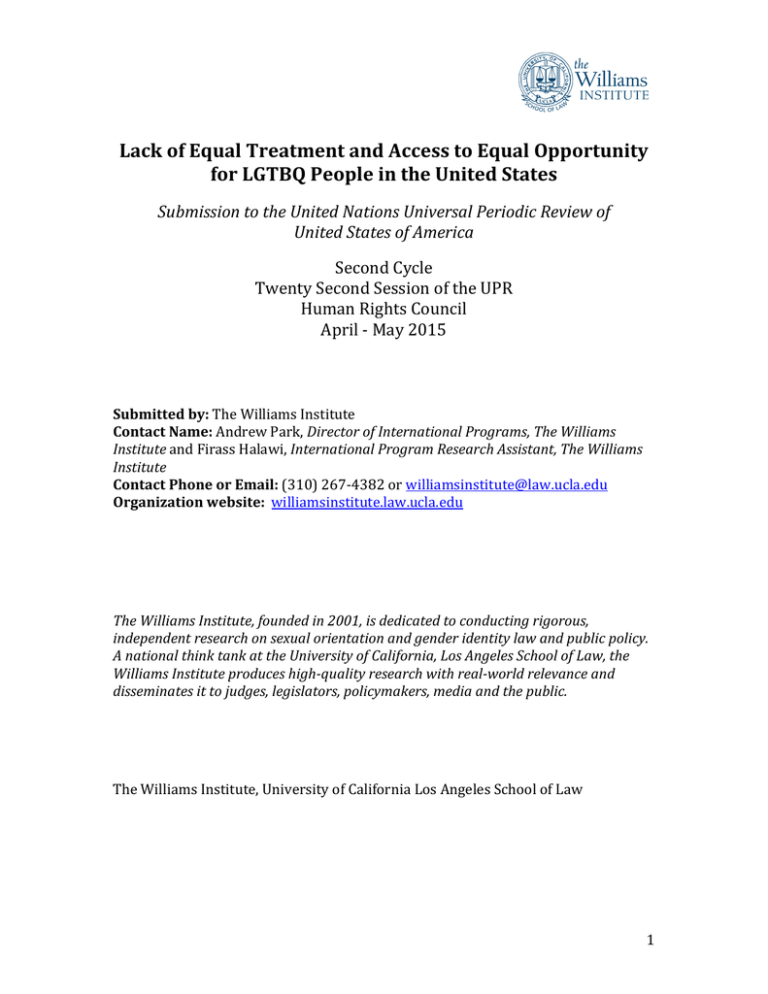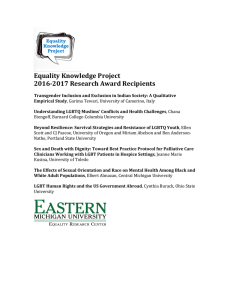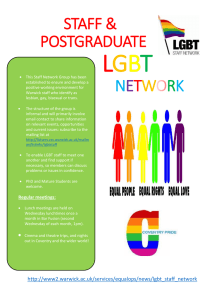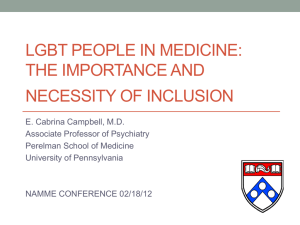
Lack of Equal Treatment and Access to Equal Opportunity
for LGTBQ People in the United States
Submission to the United Nations Universal Periodic Review of
United States of America
Second Cycle
Twenty Second Session of the UPR
Human Rights Council
April - May 2015
Submitted by: The Williams Institute
Contact Name: Andrew Park, Director of International Programs, The Williams
Institute and Firass Halawi, International Program Research Assistant, The Williams
Institute
Contact Phone or Email: (310) 267-4382 or williamsinstitute@law.ucla.edu
Organization website: williamsinstitute.law.ucla.edu
The Williams Institute, founded in 2001, is dedicated to conducting rigorous,
independent research on sexual orientation and gender identity law and public policy.
A national think tank at the University of California, Los Angeles School of Law, the
Williams Institute produces high-quality research with real-world relevance and
disseminates it to judges, legislators, policymakers, media and the public.
The Williams Institute, University of California Los Angeles School of Law
1
Executive Summary
The Williams Institute, University of California School of Law
UPR Cycle 2, Session 22,
Review of United States of America
Lack of Equal Treatment and Access to Equal Opportunity for LGTBQ People in the
United States
1. The United States during the 2010 Universal Periodic Review (UPR) accepted
three recommendations that reference sexual orientation and gender
identity. Together, recommendations 86, 112, and 116 require the United
States to take all necessary measures to comprehensively address
discrimination against individuals on the basis of their sexual orientation or
gender identity by encouraging the equal treatment of lesbian, gay, bisexual,
and transgender (LGBT) people. These requirements supplement existing
statutory and constitutional obligations.
2. Evidence indicates that in the United States, however, LGBT people continue
to be subject to human rights violations in the areas of employment, poverty,
hate crimes, and health. Sexual minority youth and transgender individuals
are uniquely vulnerable. Moreover, law enforcement often fails to protect
LGBT people and can, in fact, precipitate these forms of discrimination.
Continued unequal treatment and barriers to access to justice indicates that
the United States is not fulfilling its obligations under the 2010 UPR.
3. This submission relies on expert quantitative, qualitative, and policy analyses
based on the best available data.
Summary of Recommendation/Brief statement which to send to USHRN:
4. The U.S. Government should expand and improve its efforts to collect quality
data on the LGBT population and prohibit any form of discrimination on the
basis of sexual orientation or gender identity. In addition, the U.S. should
create a national human rights institution, or empower a currently existing
institution, in compliance with the Paris Principles, to coordinate the
monitoring of the living situation of LGBT people in the U.S., for the purposes
of determining whether LGBT people have the enjoyment of their human
rights.
2
I. Legal Frameworks for the Promotion and Protection of LGBT Rights in the
United States
5. The United States accepted three recommendations pertaining to LGBT
people during the 2010 UPR.
a. Recommendation 86: Undertake awareness-raising campaigns for
combating stereotypes and violence against gays, lesbians, bisexuals
and transsexuals, and ensure access to public services paying
attention to the special vulnerability of sexual workers to violence and
human rights abuses.
b. Recommendation 112: Take measures to comprehensively address
discrimination against individuals on the basis of their sexual
orientation or gender identity.
c. Recommendation 116: Continue its intense efforts to undertake all
necessary measures to ensure fair and equal treatment of all persons,
without regard to sex, race, religion, colour, creed, sexual orientation,
gender identity or disability, and encourage further steps in the
regard.
6. In addition to these recommendations, relevant legal frameworks include: 1)
the Mathew Shepard and James Byrd, Jr. Hate Cries Prevention Act (HCPA), a
federal law protecting individuals from bias-motivated crimes based on their
perceived gender, sexual orientation, or gender identity, 2) the Hate Crimes
Statistics Act of 1990, which requires the Attorney General to collect data on
crimes committed because of a victim’s sexual orientation, 3) Title VII of the
Civil Rights Act of 1964, which prohibits employment discrimination based
on sex, race, religion, and national origin (though some judicial and
administrative interpretation has included sexual orientation and gender
identity as protected classes, they are not listed in the statute), as well as
equal protection and due process requirements of the U.S. Constitution.
7. Title VII of the Civil Rights Act of 1964, which prohibits employment
discrimination based on sex, race, religion, and national origin (sexual
orientation and gender identity are not listed, though some courts as well as
administrative decisions have concluded that the law covers sexual
orientation as well as gender identity), as well as equal protection and due
process requirements of the U.S. Constitution which requires fair treatment
in many areas of employment, public accommodations and housing.
3
II. U.S. Compliance with Legal Obligations and Expectations for LGBT people
Employment Discrimination
8. Currently, there are slightly more than one million LGBT employees working
for state and local governments, over two hundred thousand LGBT people
working for the federal government, and just under seven million LGBT
private employees, accounting for roughly four percent of the American labor
force. 1
9. Thirty-seven percent of lesbian and gay people, and 90 percent of
transgender people, report having faced harassment in the workplace. 2 Yet,
employment discrimination on the basis of sexual orientation or gender
identity is not prohibited by federal statute or in most state statutes. Aside
from interpretation to broaden Title VII, under federal law it is entirely legal
to fire someone based on his or her sexual orientation. Only 45 percent of
American workers live in a jurisdiction prohibiting sexual orientation
discrimination in employment, and only 34 percent of workers live in a
jurisdiction prohibiting gender identity discrimination. 3
10. Public/governmental employees also receive limited constitutional
protections from discrimination based on sexual orientation or gender
identity. 4 In addition, UPR recommendations 112 and 116 require the U.S. to
address discrimination in all forms, including public and private
employment. Access to a fair workplace is a basic human right that can be
advanced with straightforward change in federal and state policy.
Hate Crimes and Law Enforcement
11. Federal law defines “hate crimes” as those criminal offenses against a person
or property motivated in whole or in part by an offender’s bias against a race,
religion, disability, ethnic origin, or sexual orientation.
1
12. The Matthew Shepard and James Byrd, Jr., Hate Crimes Prevention Act of
2009 added protections for LGBT people. The Act gave the federal
government authority to prosecute violent hate crimes including violence
Brad Sears et al., Williams Inst., Documenting Discrimination Based on Sexual Orientation and Gender
Identity in State Employment, WILLIAMSINSTITUTE.LAW.UCLA.EDU 2 (Sept. 2009),
http://williamsinstitute.law.ucla.edu/wp-content/uploads/ExecutiveSummary1.pdf
2
Jennifer C. Pizer, Brad Sears, Christy Mallory, and Nan D. Hunter, “Evidence of Persistent and Pervasive
Workplace Discrimination Against LGBTQ People: The Need for Federal Legislation Prohibiting
Discrimination and Providing for Equal Employment Benefits,” 45 LOY. L.A. L.
REV. 715 (2012).
3
Lee Badgett et al., Ctr. for Am. Progress & Williams Inst., An Executive Order to Prevent Discrimination
Against LGBT Workers, WILLIAMSINSTITUTE.LAW.UCLA.EDU 4 (Feb. 2013),
http://williamsinstitute.law.ucla.edu/wp-content/uploads/LGBTExecutiveOrder-Feb-2013.pdf
4
Sears et al., supra note 1, at 1
4
and attempted violence directed at the LGBT people. The Act provides
funding and technical assistance to state, local, and tribal jurisdictions to help
them more effectively investigate, prosecute, and prevent hate crimes. In
addition, the Act awards jurisdiction to federal officials to pursue hate crimes
that local officials decline to pursue.
13. Studies indicate that sexual orientation-based hate crimes make up
approximately 30 percent of the reported hate crimes in the United States. 5
This number is especially alarming because LGBT people make up an
estimated 3.5 percent of the American population. 6 These statistics may not
fully represent the actual number of hate crimes against LGBT people
because state and local agencies are not required to report hate crimes to the
FBI. 7 In addition, a large number of LGBT victims do not report their
victimization to the authorities because of fear of further victimization. 8
14. Ten out of every 100,000 LGBT people in the U.S. report having had a hate
crime committed against their persons. 9 This statistic is especially significant
given the fact that sexual orientation-motivated hate crimes against persons
tend to be more violent and are more likely to require hospitalization than
other types of hate crimes directed at other minority groups. 10 Gay men in
particular are especially vulnerable to being victimized. Gay men face the
highest rates of physical assaults and other types of crimes against their
persons. 11 Gay men report the greatest risk of being the victims of hatemotivated physical violence when compared with lesbians, bisexuals, Blacks,
and Jews, with 26 in 100,000 gay men reporting hate crimes against
persons. 12
15. To increase our understanding of hate crimes against LGBT people, data
collection efforts by state and local law enforcement agencies must be
improved and expanded.
5
16. Regarding law enforcement, a well-trained police force is central to
compliance with human rights standards. However, recent studies indicate
Rebecca L. Stotzer, Williams Inst., Comparison of Hate Crime Rates Across Protected and Unprotected
Groups – An Update, WILLIAMSINSTITUTE.LAW.UCLA.EDU 1 (Jan. 2012),
http://williamsinstitute.law.ucla.edu/wp-content/uploads/Stotzer-Hate-Crime-Update-Jan-2012.pdf
6
Id at 2
7
Id
8
National Coalition of Anti-Violence Programs, Lesbian, Gay, Bisexual,Transgender, Queer and HIVAffected Hate Violence in 2013 (2014).
9
Kuehnle, K., & Sullivan, A. (2003). Gay and lesbian victimization: Reporting factors in domestic violence
and bias incidents. Criminal Justice and Behavior, 30, 85-96; Winer, A. S. (1994). Hate crimes,
homosexuals, and the Constitution. Harvard Civil Rights – Civil Liberties Law Review, 29, 387-438.
10
Stotzer, supra note 5, at 3
11
Stotzer, supra note 5, at 1
12
Stotzer, supra note 5, at 1
5
areas for improvement in how police officers interact with LGBT people. For
example, 31 percent of survivors of same-sex partner violence experienced
verbal abuse from the police, and over time the trend seems to be getting
worse. 13
17. Transgender women and people of color are consistently targeted by LGBT
hate-violence. Only a small proportion of these individuals seek police
assistance, however, because they have themselves experienced police
hostility. 14 The Violence Against Women Act, which is LGBT inclusive, may
help ensure the human rights of LGBT people.
Poverty
18. Many LGBT people are below or near the federal poverty line, and LGBT
people continue to be economically disadvantaged and at higher risk for
poverty compared to non-LGBT people. 15 More than one in four LGBT adults
(29%), approximately 2.4 million people, are likely to have experienced a
time in the last year when they did not have enough money to feed
themselves or their family. 16
19. In another indication of poverty, same-sex couples are more likely to receive
government cash assistance than different-sex couples. 17 In addition,
variables that affect poverty such as education, geography, race, and gender
tend to negatively affect same-sex couples or LGBT adults more than
different-sex couples or heterosexual adults. 18
13
20. Children of same-sex couples are especially vulnerable to poverty compared
to children of different-sex couples. Almost one in four children living with a
male same-sex couple and 19 percent of children living with a female samesex couple are in poverty, compared to 12 percent of children living with
married different-sex couples. 19 African American children in gay male
Andrew Park & Adam P. Romero, Williams Inst., Universal Periodic Review of the United States UPR
Sub-group on Civil Rights and Racial and Ethnic Discrimination Issues,
WILLIAMSINSTITUTE.LAW.UCLA.EDU 2 (July 2014), http://williamsinstitute.law.ucla.edu/wpcontent/uploads/wi-UPR-statement-jul-2014.pdf
14
Id.
15
M.V. Lee Badgett, Laura E. Durso, & Alyssa Schneebaum, The Williams Institute, “New Patterns of
Poverty in the Lesbian, Gay, and Bisexual Community” (June 2013),
http://williamsinstitute.law.ucla.edu/wp-content/uploads/LGB-Poverty-Update-Jun-2013.pdf; Randy
Albelda, M.V. Lee Badgett, Gary J. Gates, and Alyssa Schneebaum, The Williams Institute, "Poverty in the
Lesbian, Gay Bisexual Community" (March 2009).
16 Gary J. Gates, Williams Inst., Food Insecurity and SNAP (Food Stamps) Participation in LGBT
Communities, WILLIAMSINSTITUTE.LAW.UCLA.EDU 1 (Feb. 2014),
http://williamsinstitute.law.ucla.edu/wp-content/uploads/Food-Insecurity-in-LGBTCommunities.pdf
17
Badgett, Durso, Schneebaum, supra note15
18
Id.
19
Id.
6
households have the highest poverty rate (52%) of any children in any
household type. 20
21. Poverty can constitute a human rights violation in three ways: 1) Disparate
rates of poverty can indicate underlying violations, such as employment
discrimination or exclusion from education, 2) poverty can cause subsequent
violations such as inability to access justice or health, and 3) poverty itself
can constitute a violation if it becomes severe enough to constitute a social
exclusion. In any case, it is the duty of the United States to monitor the
human rights situation of LGBT people through data collection and analysis.
Health
22. Since the adoption of the Affordable Care Act, the percentage of LGBT adults
without health insurance has declined. However, LGBT adults are still more
likely to be uninsured than their non-LGBT counterparts. 21 About 25 percent
of LGBT adults struggle to afford healthcare. 22 Moreover, LGBT adults are
less likely to have a place where they can seek consistent medical care and
are more likely to not seek medical attention when needed due to financial
constraints. 23 Note that this disparity in access to better health and health
care is correlated with the financial disparity between LGBT and non-LGBT
adults.
23. LGBT women are most at risk when it comes to accessing health care. 24
Compared to non-LGBT women, LGBT women are more likely to struggle to
afford healthcare or medicine (19% vs. 29%). 25 In addition, LGBT women
(29%) are almost twice as likely as non-LGBT women (16%) to lack a
personal doctor. 26
LGBTQ Youth
24. LGBTQ 27 youth are especially vulnerable group in the United States. Of the
estimated 3.2 million LGBTQ youth in the U.S., half are considered to be atrisk youth. 28 They are more likely to experience adverse health outcomes
20
Id. Children of same-sex couples do not necessarily identify as LGBTQ.
Gary J. Gates, In U.S., LGBT More Likely Than Non-LGBT to Be Uninsured, Gallup Well-Being (Aug.
26, 2014), http://www.gallup.com/poll/175445/lgbt-likely-non-lgbt-uninsured.aspx.
22 Id.
23 Id.
24
Id.
25
Id.
26
Id.
27
Q stands for those who identify as queer and/or are questioning their sexual identity as LGBT.
28
Christy Mallory et al., Williams Inst., Ensuring Access to Mentoring Programs for LGBTQ Youth,
WILLIAMSINSTITUTE.LAW.UCLA.EDU 1 (Jan. 2014), http://williamsinstitute.law.ucla.edu/wpcontent/uploads/Access-to-Youth-Mentoring-Programs.pdf
21
7
than non-LGBTQ youth and are more likely to self-mutilate, experience
depression, and engage in suicide ideation, planning, and attempts. 29
25. According to a new study in the American Journal of Public Health, 23 percent
of sexual minority youth compared with seven percent of heterosexual youth
had attempted suicide in the year prior to being surveyed. 30 The same study
also isolated and compared serious suicides attempts—those that result in
serious injury and require medical treatment. The study found that sexual
minority youth were four times as likely as heterosexual youth to commit
serious suicide attempts. 31
26. LGBTQ youth disproportionately engage in behaviors that experts have
identified as putting youth at high risk for involvement with the juvenile
justice system. 32 LGBTQ youth, for example, are at higher risk of experiencing
bullying, absenteeism, and other school-related problems, as well as
depression, drug use, and involvement in certain types of crimes than their
non-LGBTQ counterparts. 33 This risk is exacerbated by a lack of support at
home and in school. LGBTQ youth rank non-accepting families as the most
important problem in their lives; in addition, more than 70 percent of LGBTQ
youth report feeling unsafe at school due to their sexual orientation or
gender expression. 34 Indeed, LGBTQ youth are twice as likely to consider
dropping out of school and are more likely to end up homeless or in foster
care as compared to non-LGBTQ youth. Moreover, of the 1.6 million at-risk
LGBTQ youth, just over 1.3 million have never had structured mentorship
and just over six hundred thousand have never had a mentor of any kind. 35
Recommendation 86 would require the U.S. government to combat the
stereotypes the LGBTQ youth face.
27. The lack of accepting families and schools diminishes LGBTQ accessibility to
a support system, which might address underlying risky behavior, as they are
left isolated to deal with severe psychosocial problems that can often become
life threatening. All these factors, including selective law enforcement,
contribute to the overrepresentation of LGBTQ youth in the juvenile justice
system. 36 While seven percent of youth generally identify as LGBTQ, almost
14 percent of youth in custody identify as LGBTQ. 37
29
Wendy B. Bostwick et al., Mental Health and Suicidality Among Racially/Ethnically Diverse Sexual
Minority Youths, Williams Institute (July 2014), http://williamsinstitute.law.ucla.edu/research/safe-schoolsand-youth/ajph-jul-2014/
30
Id.
31
Id.
32
Mallory, supra note 28, at 10
33
Id. at 7
34
Id. at 1
35
Id. at 2
36
Id. at 9
37
Id. at 1
8
III. Recommendations
Legislation to comply with human rights standards
28. Federal and state governments should prohibit employment discrimination
on the basis of sexual orientation or gender identity in both the public and
private sectors.
29. Federal and state governments should recognize same-sex relationships to
the extent such relationships are recognized for opposite sex-couples,
including removing bans on same-sex marriage.
30. Federal and state governments should adopt anti-bullying laws to reduce
harassment and violence against LGBTQ youth in schools, foster care, social
services agencies, family court, shelters, and the juvenile justice system.
Human rights monitoring mechanisms
31. The United States should create a national human rights institution, or
empower a currently existing institution, in compliance with the Paris
Principles, to coordinate the monitoring of the living situation of LGBT
people in the U.S., for the purposes of determining whether LGBT people
have the enjoyment of their human rights. This body should have the
authority to investigate, adjudicate, and formulate responses to human rights
concerns involving sexual orientation or gender identity.
32. The United States should expand and improve its efforts to collect quality
data on the LGBT population, including but not limited to demographic,
economic, geographic, and health characteristics. For example, the United
States should add sexual orientation and gender identity measures to the
Decennial Census and other federal and state surveys. 38 These data would
enable the U.S. to better understand, asses, and remedy the adverse social,
economic, and health disparities LGBT people experience.
Youth
33. All levels of government should encourage LGBTQ-focused youth mentoring
programs in order to help address the challenges and vulnerabilities many of
these youth face.
38
See SMART report for suggested questions for identifying sexual orientation. Elbert Almazan et al.,
SMART & Williams Inst., Best Practices for Asking Questions about Sexual Orientation on Surveys,
WILLIAMSINSTITUTE.LAW.UCLA.EDU (Nov. 2009), http://williamsinstitute.law.ucla.edu/wpcontent/uploads/SMART-FINAL
9
Law Enforcement
34. The United States should support training of law enforcement officers to
appropriately respond to requests for assistance by LGBT people, including
training on LGBT-cultural competence; the DOJ should revise its “Guidance
Regarding the Use of Race by Federal Law Enforcement Agencies” to include
sexual orientation, gender identity, gender expression, immigration status,
and housing status; and the Uniform Crime Report and the United States
Department of Justice’s National Crime Victimization Survey should include
questions regarding the sexual orientation and gender identity of both
survivors and offenders. 39
Midterm Review
35. The United States should participate in a UPR Midterm Review. Conclusion
Summary
36. LGBT people continue to be subject to human rights violations in the areas of
employment, poverty, hate crimes, and health. Continued unequal treatment
and barriers to access to justice indicates that the U.S. is not fulfilling its
obligations under the 2010 UPR. Therefore, the U.S. should expand and
improve its efforts to collect quality data on the LGBT population and
prohibit any form of discrimination on the basis of sexual orientation or
gender identity.
39
Park & Romero, supra note 13,
10



